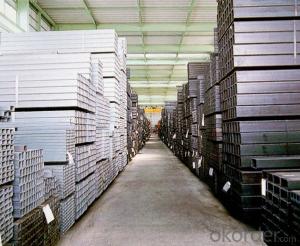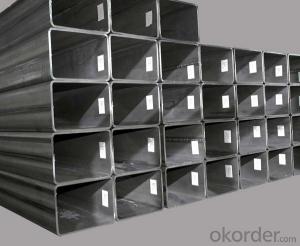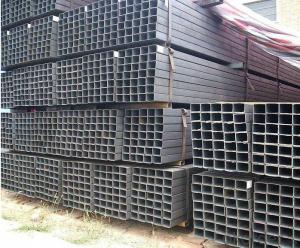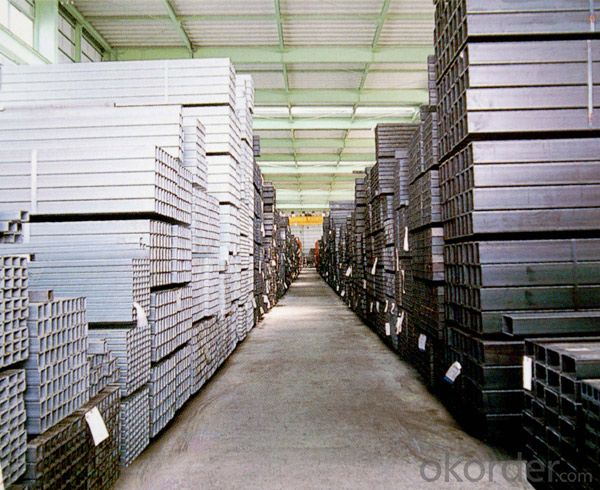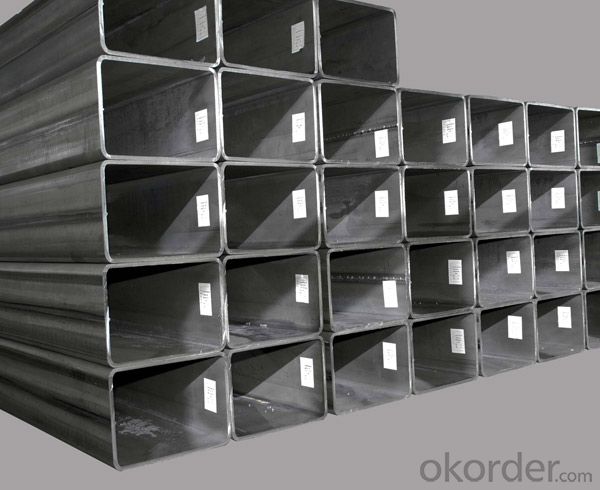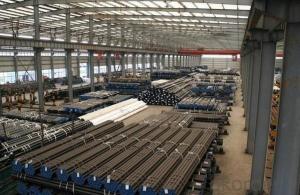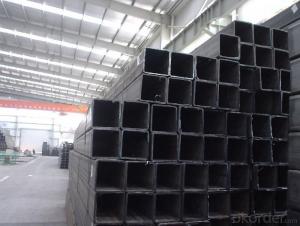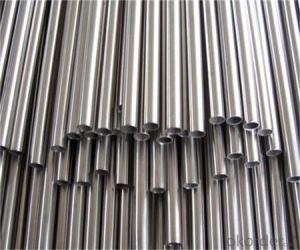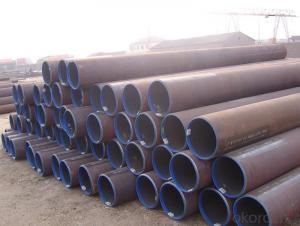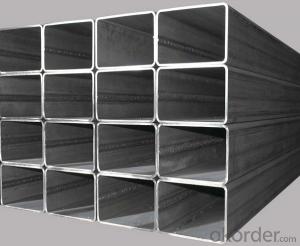Hollow Section-Square Pipes With Lowest price
- Loading Port:
- Tianjin
- Payment Terms:
- TT OR LC
- Min Order Qty:
- 25 m.t.
- Supply Capability:
- 10000 m.t./month
OKorder Service Pledge
OKorder Financial Service
You Might Also Like
Carbon ERW Welded Pipes-Square Tube And Pipe For Furniture ASTM A53 Hollow Section Details:
| Minimum Order Quantity: | 50MT | Unit: | m.t. | Loading Port: | China Main Port |
| Supply Ability: | based on order | Payment Terms: | TT or L/C |
Product Description:
1. Specification of ERW Welded Pipes-Square Tube and Pipe for Furniture ASTM A53 Hollow Section
1) Application: Greenhouse pipes, scaffolding pipes, transportation the ocean oil and gas, mechanical tube of ocean platform, power station, chemical industry and building, construction foundation piles, steel structure building, for low-pressur fluid service, steel structure bridges etc.
2) Standard: ASTM A53, BS1387, GB/T9711, GB/T39013
3) Steel Grade: Q195/Q215/Q235/Q345
2. Sizes of ERW Welded Pipe- Square Tube and Pipe for Furniture ASTM A53 Hollow Section
Outer Diameter: 1/2"x1/2"-16"x16''
Thickness:4.0-12.75mm
Length: As costumer's requirement
2. Packing & Delivery
Packing Detail: Packing in bundle with steel strips;with seaworthy package at the end; could be done with your requirement
Delivery Time: Within 30 Days after the reception of prepayment or L/C
3. Data Sheet
Standard: ASTM A53
Mechanical Properties
Standard | Grade | (MPa) | (MPa) |
Yield strength | Tensile Strength | ||
ASTM A53M | A | 205 | 330 |
B | 240 | 415 |
Chemical Composition(%)
Standard | Grade | C | Mn | P | S | V | Ni | Cu | Cr | Mo |
Max | Max | Max | Max | Max | Max | Max | Max | Max | ||
ASTM A53M | A | 0.25 | 0.95 | 0.05 | 0.045 | 0.08 | 0.4 | 0.5 | 0.4 | 0.15 |
B | 0.30 | 1.20 | 0.05 | 0.045 | 0.08 | 0.4 | 0.5 | 0.4 | 0.15 |
- Q: What are the safety regulations for working with steel pipes?
- The safety regulations for working with steel pipes vary depending on the specific tasks involved, but some common regulations include wearing appropriate personal protective equipment (PPE) such as gloves, safety glasses, and steel-toed boots, ensuring proper ventilation in enclosed spaces, following proper lifting techniques to prevent back injuries, implementing proper fall protection measures when working at heights, and using caution when handling tools and equipment to prevent accidents and injuries. It is important to consult the relevant guidelines and regulations specific to your jurisdiction and industry to ensure compliance and promote a safe working environment.
- Q: How do you repair damaged steel pipes?
- To repair damaged steel pipes, there are several steps that can be followed: 1. Identify the extent of the damage: Assess the severity of the damage to determine if it can be repaired or if the pipe needs to be replaced altogether. 2. Isolate and drain the section: Shut off the water supply to the damaged section of the pipe and drain any remaining water to prevent further leakage or damage. 3. Clean the damaged area: Remove any dirt, rust, or other debris from the damaged area. This can be done using a wire brush or sandpaper. 4. Prepare the damaged area: Roughen the surface of the damaged area using coarse sandpaper. This will help the repair material adhere better to the pipe. 5. Choose a repair method: Depending on the size and location of the damage, there are various repair methods available. Some common options include using epoxy putty, pipe wraps, or clamps. 6. Apply the repair material: Follow the instructions provided with the chosen repair method to apply the material to the damaged area. Ensure that it covers the entire damaged section and extends slightly beyond it for added protection. 7. Allow the repair to cure: Give the repair material sufficient time to cure as per the manufacturer's instructions. This will ensure a strong bond and effective sealing of the damaged area. 8. Test the repair: Once the repair has cured, turn the water supply back on and check for any leaks. If there are no signs of leakage, the repair is successful. Otherwise, reevaluate the repair or consider seeking professional assistance. It is important to note that these steps provide a general guideline for repairing damaged steel pipes. However, the specific repair method may vary depending on the size and severity of the damage. In complex cases or if unsure, it is recommended to consult a professional plumber or pipe repair specialist.
- Q: What are the different types of steel pipe coatings for nuclear power plants?
- There are several types of steel pipe coatings used in nuclear power plants, including epoxy coatings, polyethylene coatings, fusion bonded epoxy coatings, and coal tar enamel coatings. These coatings are applied to steel pipes to provide protection against corrosion, enhance durability, and maintain the integrity of the pipes in the demanding environment of nuclear power plants.
- Q: How are steel pipes used in the manufacturing of pressure vessels?
- Steel pipes are commonly used in the manufacturing of pressure vessels as they provide the necessary strength and durability to withstand high internal pressure. These pipes are welded or seamless and are often used as the main structural component of the vessel. They allow for the efficient flow of fluids or gases within the vessel and provide a reliable and secure containment system for various industrial applications.
- Q: How do you calculate the flow rate through a steel pipe?
- Several factors need to be considered in order to calculate the flow rate through a steel pipe. The crucial factors include the pipe's diameter, the pressure difference across the pipe, and the properties of the fluid flowing through it. Accurate measurement of the inside diameter of the steel pipe is the first step. This measurement is vital as it determines the cross-sectional area through which the fluid flows. Ensure that the units used for the diameter measurement are consistent with the units used for other measurements. Next, determine the pressure difference across the pipe. This can be accomplished by measuring the pressure at two points along the pipe, typically at the inlet and outlet. It is important to take the pressure measurements at the same height in order to avoid any discrepancies. The pressure difference is usually given in units of pressure, such as psi, kPa, or bar. Once you have the diameter and pressure difference, you can utilize either the Bernoulli equation or the Darcy-Weisbach equation to calculate the flow rate. The Bernoulli equation establishes a relationship between the pressure difference and the fluid's velocity. However, this equation assumes ideal conditions and overlooks factors like friction losses, viscosity, and turbulence. On the other hand, the Darcy-Weisbach equation is more accurate as it considers these factors. To employ the Darcy-Weisbach equation, you must be aware of the fluid's properties that flow through the pipe, such as density and viscosity. These properties can be determined either through experimentation or by referring to literature values. After gathering all the necessary information, you can use the Darcy-Weisbach equation: Q = (π/4) * D^2 * √[(2 * ΔP) / (ρ * f * L)] Where: Q represents the flow rate, measured in cubic meters per second or any other consistent units. D is the diameter of the pipe, measured in meters or any other consistent units. ΔP is the pressure difference across the pipe, measured in Pascals or any other consistent units. ρ is the density of the fluid flowing through the pipe, measured in kilograms per cubic meter or any other consistent units. f signifies the friction factor, which relies on the Reynolds number and the roughness of the pipe. L represents the length of the pipe, measured in meters or any other consistent units. By substituting the appropriate values for all the variables, you can accurately calculate the flow rate through the steel pipe.
- Q: What is the fatigue strength of steel pipes?
- The fatigue strength of steel pipes refers to their ability to withstand repeated cyclic loading without experiencing failure. It is a critical characteristic for pipes that are subject to dynamic or fluctuating loads, such as those used in the oil and gas industry, transportation infrastructure, or industrial applications. The fatigue strength of steel pipes can vary depending on several factors, including the steel grade, pipe dimensions, manufacturing process, surface conditions, and environmental factors. Steel pipes with higher tensile strength and toughness generally exhibit better fatigue resistance. The fatigue strength is typically determined through fatigue testing, which involves subjecting the pipes to cyclic loading until failure occurs. The results are then used to establish a fatigue curve or S-N curve, which represents the relationship between the applied stress amplitude and the number of cycles to failure. The fatigue strength is commonly expressed as the stress amplitude required to cause failure after a specific number of cycles, such as the stress amplitude at 10 million cycles (S-N10^7). It is important to note that fatigue strength is influenced by other factors, such as mean stress, surface finish, and loading frequency, which may need to be considered in specific applications. Overall, the fatigue strength of steel pipes is a crucial factor to consider in engineering design and maintenance, as it helps ensure the long-term integrity and reliability of the pipes under cyclic loading conditions.
- Q: How do you calculate the pipe pressure drop coefficient for steel pipes?
- To determine the pipe pressure drop coefficient for steel pipes, one can utilize the Darcy-Weisbach equation. This equation establishes a relationship between the pressure drop within a pipe and various factors, including the flow rate, pipe diameter, pipe length, and the properties of the fluid being conveyed. The pressure drop coefficient, also known as the friction factor or the Darcy-Weisbach friction factor, is represented by the symbol f and is dimensionless. It denotes the resistance to flow within the pipe. The value of f is contingent upon the flow regime, which can either be laminar or turbulent. In the case of laminar flow, occurring at low flow rates or with viscous fluids, the pressure drop coefficient can be determined through employment of the Hagen-Poiseuille equation. This equation relates the pressure drop to the fluid viscosity, pipe length, pipe diameter, and flow rate. However, for turbulent flow, arising at higher flow rates, the calculation of the pressure drop coefficient becomes more intricate. It is influenced by the roughness of the pipe wall, which impacts flow resistance. Typically, roughness is quantified using the relative roughness, defined as the ratio of the pipe wall roughness to the pipe diameter. To compute the pressure drop coefficient for turbulent flow in steel pipes, empirical correlations or Moody's diagram can be utilized. Moody's diagram provides a graphical depiction of the friction factor as a function of the Reynolds number and relative roughness. The Reynolds number characterizes the flow regime and is determined using fluid properties, flow rate, and pipe dimensions. By identifying the intersection of the Reynolds number and relative roughness on Moody's diagram, one can ascertain the corresponding pressure drop coefficient. It is crucial to note that the pressure drop coefficient for steel pipes may vary depending on specific pipe dimensions, surface roughness, and fluid properties. Consequently, it is advisable to refer to relevant standards or engineering sources for precise and current values of the pressure drop coefficient for steel pipes in a particular application.
- Q: How are steel pipes classified based on their diameter?
- Steel pipes are classified based on their diameter by categorizing them into different size ranges, such as small diameter pipes, medium diameter pipes, and large diameter pipes.
- Q: What's the difference between No. 20 steel pipe and 27SiMn Steel Pipe?
- 27SiMn =27 - steel pipe, which is a seamless steel tube material, the carbon content in 0.24 - 0.32%, SIMN single because it five elements (carbon manganese silicon Si, C, Mn, P P, S, guimeng sulfur) the high content of about 1.10 - 1.40%.
- Q: What are the different methods of insulating steel pipes?
- There are several methods of insulating steel pipes, including using insulation wraps, foam insulation, fiberglass insulation, and pre-insulated pipe systems. Insulation wraps are typically made of materials like rubber or polyethylene and are wrapped around the pipe to provide thermal insulation. Foam insulation involves applying a layer of foam insulation directly onto the surface of the pipe. Fiberglass insulation is another common method, where fiberglass material is wrapped around the pipe to provide insulation. Pre-insulated pipe systems are complete pipe systems that come with built-in insulation and are ready to be installed. These methods help prevent heat loss or gain in the pipes, maintain temperature control, and prevent condensation.
Send your message to us
Hollow Section-Square Pipes With Lowest price
- Loading Port:
- Tianjin
- Payment Terms:
- TT OR LC
- Min Order Qty:
- 25 m.t.
- Supply Capability:
- 10000 m.t./month
OKorder Service Pledge
OKorder Financial Service
Similar products
Hot products
Hot Searches
Related keywords
